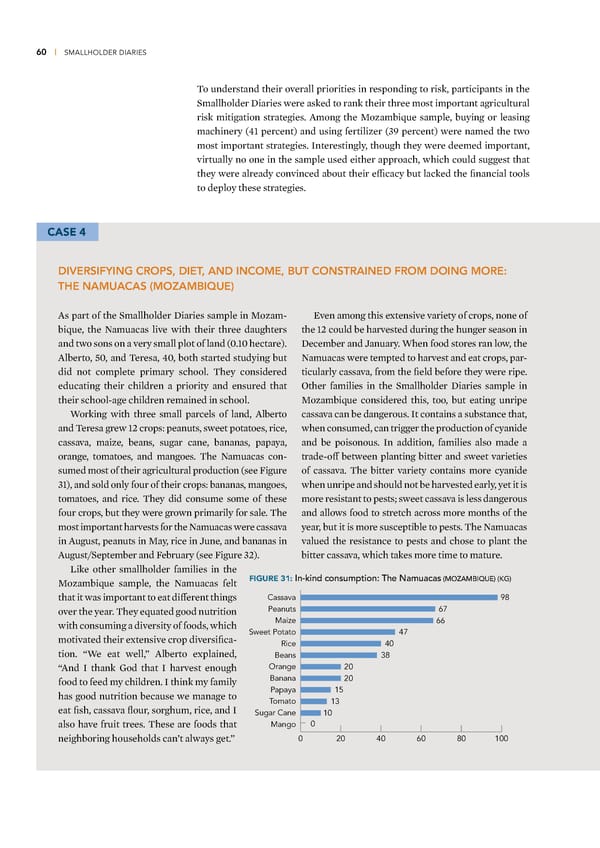60 | SMALLHOLDER DIARIES Œo understand their overall priorities in responding to ris, participants in the Smallholder ‰iaries were ased to ran their three most important agricultural ris mitigation strategies ˆmong the –o—ambiue sample, buying or leasing machinery (“… percent) and using fertili—er (Ÿž percent) were named the two most important strategies €nterestingly, though they were deemed important, virtually no one in the sample used either approach, which could suggest that they were already convinced about their efficacy but laced the financial tools to deploy these strategies CASE 4 DIVERSIFYING CROPS, DIET, AND INCOME, BUT CONSTRAINED FROM DOING MORE: THE NAMUACAS (MOZAMBIQUE) ˆs part of the Smallholder ‰iaries sample in –o—am- œven among this extensive variety of crops, none of biue, the ˜amuacas live with their three daughters the …‘ could be harvested during the hunger season in and two sons on a very small plot of land (’…’ hectare) ‰ecember and Žanuary ™hen food stores ran low, the ˆlberto, ”’, and Œeresa, “’, both started studying but ˜amuacas were tempted to harvest and eat crops, par- did not complete primary school Œhey considered ticularly cassava, from the field before they were ripe educating their children a priority and ensured that ¦ther families in the Smallholder ‰iaries sample in their school-age children remained in school –o—ambiue considered this, too, but eating unripe ™oring with three small parcels of land, ˆlberto cassava can be dangerous €t contains a substance that, and Œeresa grew …‘ crops peanuts, sweet potatoes, rice, when consumed, can trigger the production of cyanide cassava, mai—e, beans, sugar cane, bananas, papaya, and be poisonous €n addition, families also made a orange, tomatoes, and mangoes Œhe ˜amuacas con- trade-off between planting bitter and sweet varieties sumed most of their agricultural production (see igure of cassava Œhe bitter variety contains more cyanide Ÿ…), and sold only four of their crops bananas, mangoes, when unripe and should not be harvested early, yet it is tomatoes, and rice Œhey did consume some of these more resistant to pests sweet cassava is less dangerous four crops, but they were grown primarily for sale Œhe and allows food to stretch across more months of the most important harvests for the ˜amuacas were cassava year, but it is more susceptible to pests Œhe ˜amuacas in ˆugust, peanuts in –ay, rice in Žune, and bananas in valued the resistance to pests and chose to plant the ˆugust¤September and ebruary (see igure Ÿ‘) bitter cassava, which taes more time to mature ƒie other smallholder families in the –o—ambiue sample, the ˜amuacas felt FIGURE 31: In-kind consumption: The Namuacas (MOZAMBIQUE) (KG) that it was important to eat different things Cassava 98 over the year Œhey euated good nutrition Peanuts 67 with consuming a diversity of foods, which Maize 66 motivated their extensive crop diversifica- Sweet Potato 47 Rice 40 tion “™e eat well,” ˆlberto explained, Beans 38 “ˆnd € than ‡od that € harvest enough Orange 20 food to feed my children € thin my family Banana 20 has good nutrition because we manage to Papaya 15 eat fish, cassava flour, sorghum, rice, and € Tomato 13 Sugar Cane 10 also have fruit trees Œhese are foods that Mango 0 neighboring households can’t always get” 020406080 100
 Financial Diaries with Smallholder Families Page 75 Page 77
Financial Diaries with Smallholder Families Page 75 Page 77